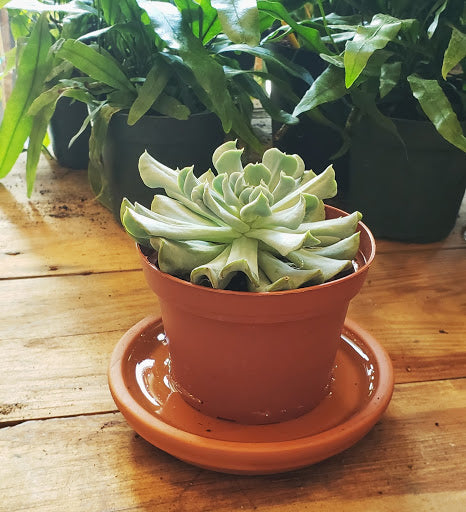Article: Should I water or wait?

Should I water or wait?
Should I water or wait?
Watering is one of the most essential tasks in plant care, though incorrectly watering is the most common reason for houseplant death. And despite what your mom says, the answer isn’t an ice cube!
First, all plants should be watered with lukewarm water to avoid shocking the plant. Second, there are many more reliable ways to ensure you don’t overwater your plants.
Watering Methods

Pictured: Calathea Ornata. Find our current selection of Calatheas here.
Most plants prefer to be watered from above by wetting the potting mix around the base of the plant. Water until the plant is evenly moist. Make sure the excess water drains away, and don’t let plants sit in water! Letting your plants sit in undrained water can result in root rot, and can damage their fragile root systems.
Pictured: Echeveria. Find our current selection of succulents and cacti here.
Plants with fuzzy leaves (like begonias) and plants that entirely cover the potting mix with their foliage (like echeveria) prefer to be watered from below. This method will keep water from splashing on the leaves, a problem that can lead to streaks and rot on leaves. It is important to use pots with drainage holes when watering from below so that the water can reach the potting mix. Fill a saucer with water, then place your pot on the saucer for roughly 30 minutes before allowing it to dry. Any plant you plan to water from below should be watered from above every few weeks to keep salts in the soils from settling on the top.
Orchids can be watered similarly, though they prefer to be watered in a large container to ensure that the water level is filled nearly the top of the pot. Let your orchid stand in the water for 10 minutes before removing the pot and allowing it to dry.
Special care needs to be used when watering pots that are closed at the bottom. Overwatering without drainage can lead to fungus gnats, or worse, root rot. Water the top soil evenly and extremely lightly, and always assess dryness before watering.
Assessing Dryness

Having a weekly assessment day can help you learn how quickly your plants dry out, though you can’t rely on a regular watering schedule since the rate at which plants require water is dependent on environmental factors. You can purchase moisture meters to stick in your soil, but knowing assessment techniques will help you become a more confident waterer.
The easiest method to check dryness is by feeling the topsoil. Push your fingers into the soil throughout the week; when the top inch feels dry, it’s often time to water most plants. Especially drought-tolerant plants need to dry out much more, which is why succulents and cacti are watered less frequently. Other plants require more moisture and like to stay lightly damp, like ferns and calatheas.
It’s also good to practice lifting plants to check weight. Take note of how heavy your pot is once you first pot your plant, prior to watering it. This should give you a sense of how light it is at its driest, including any rocks or other potting elements that you used. Then pick up your plants every few days to test them, and water the pot feels light. This can be especially helpful if your plants are in closed-bottom pots.
Overwatering

Pictured: Dracaena Jade Jewel. Find our current selection of Dracaenas here.
Overwatering is a very common plant problem, and can often cause long-term damage to your plant. Untreated root rot usually kills plants within 7-10 days, so it’s important to provide the proper care as soon as possible.
If your plant’s old and new leaves are yellowing and becoming limp at the same rate, you are likely overwatering your plant. Seeing stunted growth can also be due to underwatering as the roots have been damaged and they are unable to develop further. Heavy wilting and browning can also be linked to overwatering if the browned areas are soft and limp. Crispy, dry brown areas can sometimes be signs of underwatering.
If you believe you’ve overwatered your plant, allow it to dry completely before your next watering and try to assess more actively to prevent overwatering in the future. If you’re seeing significant wilting, you can also unpot your plant and dry the root ball with paper towels or newspaper. Then repot it in fresh soil. However if you’re not seeing any improvement, it can be best to take a clipping from the dying plant to replant and try again.
Underwatering
Though the outcome is less severe, repeatedly underwatering can also hurt your plant’s overall health. Signs of underwatering can be crispy, dry brown areas or your plant losing dried out leaves. Typically plants drop bottom leaves first when they are being underwatered. It is easier to correct overwatering as you just need to reintroduce moisture. To revive a dry plant, water the plant well and allow it to dry. Check the plant daily, watering whenever it feels dry. Do this for a few days until the plant looks perky again.
Extra Tips
Plants often need less water in the winter due to lower light and temperature. Think about watering as thoroughly as you normally would do during the growing season, however much less frequently. It is even more important to assess your plants prior to watering as overwatering is more difficult to recover from in the winter. Some plants also go into a dormancy period, like succulents and cacti, and therefore should be watered much, much less.
Plants in terracotta pots dry out faster since it’s a material that’s breathable on every side. In comparison, plants in plastic or ceramic with a drainage hole dry slower, and pots with no drainage at all dry out slowest. Adjust your watering schedule according to the pot that your plant is in.
Placement also affects how often you’ll need to water plants. Drier rooms cause soil to dry out more quickly, which can make them better places for drought tolerant plants such as snake plants. However, tropical plants housed in dry spaces may need to be watered more often. Alternatively humid spaces, like bathrooms and kitchens, are good for moisture-loving plants that can’t withstand dry environments. Hanging plants also typically dry out more quickly as they are closer to ventilation systems.
Though there are many proven methods to water plants, your plant’s needs are determined by the environment. Assessing plants successfully and knowing their watering needs will help you become a competent and confident indoor gardener. Now get growing!

